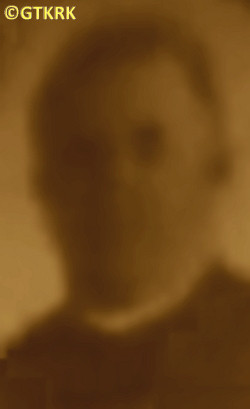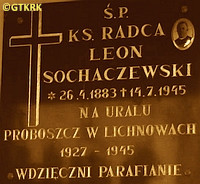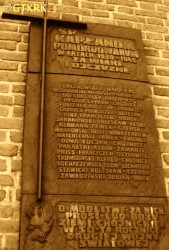Roman Catholic
St Sigismund parish
05-507 Słomczyn
85 Wiślana Str.
Konstancin deanery
Warsaw archdiocese, Poland
full list:
displayClick to display full list

searchClick to search full list by categories
wyświetlKliknij by wyświetlić pełną listę po polsku

szukajKliknij by przeszukać listę wg kategorii po polsku

Martyrology of the clergy — Poland
XX century (1914 – 1989)
personal data
surname
SOCHACZEWSKI
forename(s)
Leo Julian (pl. Leon Julian)
function
diocesan priest
creed
Latin (Roman Catholic) Church RCmore on
en.wikipedia.org
[access: 2014.09.21]
diocese / province
Culm (Chełmno) diocesemore on
pl.wikipedia.org
[access: 2012.11.23]
honorary titles
Ad Honores Spiritual Counselor
(c. 1935)
date and place
of death
14.07.1945

KLW No. 508 InzerGUPWI slave labour camp network
form.: Novaya Nogatka
today: Bashkortostan rep., Russia
alt. dates and places
of death
09.1945
details of death
After German and Russian invasion of Poland in 09.1939 and start of the World War II, during German occupation, arrested many times by Germans but each time released.
After German defeat and start in 1945 of Russian occupation arrested by Russians.
Deported to Ural mountains — together with thousands of German prisoners — to the Ural Mountains, to one of the slave POW labor camps of the Gulag system, prob. to KLW No. 508 Inzer in Republic of Bashkortostan.
Assigned to a sub‐camp in Beloretsk and sent to the mountains, to the small village of Novaya Nogatka.
There slaved cutting down forests, together with c. 18 other deportees from Mazury region in Poland.
There perished.
alt. details of death
There is a moving description of the conditions in the Novaya Nogatka camp and the details of the priest's death: „After six weeks of driving, after passing Ufa, they got off at a small station and set off into the mountains — on foot. They reached the village of Nogatka, which turned out to be the goal of their long journey. «Easy at the bottom and mountains at the top» — [the witness] describes the appearance of this place concisely. «Very high mountains» — adds. There was no railway to this town, there was no electricity. A kolkhoz, and next to it a small camp: three large barracks that formerly served as a place of isolation for Russian exiles. Even though it was the Southern Urals, the high location of Nogatka meant that snow remained there until July. And already in September a new one appeared. The short summer was quickly followed by winter. Forty‐degree frosts were starting.
Cold in the barracks. No floors, only boards here and there on which they slept, with water underneath and, more often, ice […] [Handmade] sheet metal stoves. There was nothing to burn, so they forced fresh birches. A part of it burned, they kept pushing it. There was no need to chop.
Food? Nettles, chaff, and as a delicacy — groats with rotten bream.
They worked in forest clearing, some worked in a sawmill. There they cut birch trees into meter‐long pieces, split them in half with a wedge and threw them into a heap. In July, when the snow began to melt and streams flowed down from the mountains, they threw the wood into the water and the current picked it up and carried it down.
[…] Many prisoners, especially educated ones, couldn't stand it mentally. Every now and then one was hanging in the woods.
[…] Mainly, however, thinning out took place in barracks, out of hunger and living conditions, including unbearable frost, severe for those unaccustomed to such low temperatures. Not a day passed without someone dying, and sometimes ten or more people were carried away dead. Initially, they were buried near the camp, in the mountains. Later they began to be taken away — nobody knows where. The corpses were tied with a chain and dragged onto a cart. A hand was sticking out — it was cut off.
[…] A priest from Chojnice was in the barracks. Led prayers. Fell ill, his eyes were fading. [Everything] was done to save him, to keep him alive. [They] brought him food: potatoes, milk. Despite this, the disease could not be stopped”.
cause of death
torment
perpetrators
Russians
sites and events
KLW No. 508 InzerClick to display the description, GulagClick to display the description, «Intelligenzaktion»Click to display the description, Ribbentrop‐MolotovClick to display the description, Pius XI's encyclicalsClick to display the description
date and place
of birth
26.04.1883Birth certification on:
www.genealogiawarchiwach.pl
[access: 2025.09.08]

Świecietoday: Świecie gm., Świecie pov., Kuyavia‐Pomerania voiv., Poland
more on
en.wikipedia.org
[access: 2021.09.02]
parents
SOCHACZEWSKI John
🞲 ?, ? — 🕆 ?, ?

GOŹDZIKOWSKA Mary
🞲 ?, ? — 🕆 ?, ?
presbyter (holy orders)
ordination
24.03.1912

Pelplintoday: Pelplin gm., Tczew pov., Pomerania voiv., Poland
more on
en.wikipedia.org
[access: 2021.05.06]
Assumption of the Blessed Virgin Mary RC cathedral churchmore on
en.wikipedia.org
[access: 2025.03.14]
positions held
1927 – 1945
parish priest — Lichnowytoday: Chojnice gm., Chojnice pov., Pomerania voiv., Poland
more on
en.wikipedia.org
[access: 2022.01.28] ⋄ St Hedwig of Silesia RC parish ⋄ Chojnicetoday: Chojnice urban gm., Chojnice pov., Pomerania voiv., Poland
more on
en.wikipedia.org
[access: 2021.09.02] RC deanery — also: inspector of religious education in elementary schools
from 15.02.1940
administrator — Dąbrówkatoday: Kamień Krajeński gm., Sępólno Krajeńskie pov., Kuyavia‐Pomerania voiv., Poland
more on
en.wikipedia.org
[access: 2021.09.02] ⋄ St Michael the Archangel RC parish ⋄ Kamień Pomorskitoday: Kamień Krajeński, Kamień Krajeński gm., Sępólno Krajeńskie pov., Pomerania voiv., Poland
more on
en.wikipedia.org
[access: 2021.09.02] RC deanery — acting („ad interim”)
1921 – 1927
parish priest — Białutytoday: Iłowo‐Osada gm., Działdowo pov., Warmia‐Masuria voiv., Poland
more on
en.wikipedia.org
[access: 2021.09.02] ⋄ St James the Apostle RC parish ⋄ Pomesaniadeanery name
today: Poland
more on
en.wikipedia.org
[access: 2020.11.27] RC deanery
till 1921
vicar — Grabowotoday: Lubawa gm., Iława pov., Warmia‐Masuria voiv., Poland
more on
en.wikipedia.org
[access: 2021.07.29] ⋄ Assumption of the Blessed Virgin Mary RC parish
1912 – 1916
vicar — Jeżewotoday: Jeżewo gm., Świecie pov., Kuyavia‐Pomerania voiv., Poland
more on
en.wikipedia.org
[access: 2021.09.02] ⋄ Holy Trinity RC parish ⋄ Świecietoday: Świecie gm., Świecie pov., Kuyavia‐Pomerania voiv., Poland
more on
en.wikipedia.org
[access: 2021.09.02] RC deanery
1908 – 1912
student — Pelplintoday: Pelplin gm., Tczew pov., Pomerania voiv., Poland
more on
en.wikipedia.org
[access: 2021.05.06] ⋄ philosophy and theology, Theological Seminary
sites and events
descriptions
KLW No. 508 Inzer: Russian Rus. Концентрационный Лагерь для Военнопленных (Eng. POW Concentration Camp) KLW, managed by the genocidal Russian organization NKVD — and in practice by its Rus. Главное управление по делам военнопленных и интернированных (Eng. General Directorate for Prisoners of War and Internees) GUPWI — for German POWs, headquartered in Inzer in the Republic of Bashkortostan. Organized in 03.1945 on the basis of another POW camp, KLW 208 (operating from od 01.1945). It included 7 subcamps in various places in the republic. Among others prisoners from Warmia and Mazury in Poland were kept there. It operated till 10.1945. (more on: sfrik.omsu.ruClick to attempt to display webpage
[access: 2024.04.08])
Gulag: The acronym Gulag comes from the Rus. Главное управление исправительно‐трудовых лагерей и колоний (Eng. Main Board of Correctional Labor Camps). The network of Russian concentration camps for slave labor was formally established by the decision of the highest Russian authorities on 27.06.1929. Control was taken over by the OGPU, the predecessor of the genocidal NKVD (from 1934) and the MGB (from 1946). Individual gulags (camps) were often established in remote, sparsely populated areas, where industrial or transport facilities important for the Russian state were built. They were modeled on the first „great construction of communism”, the White Sea‐Baltic Canal (1931‐1932), and Naftali Frenkel, of Jewish origin, is considered the creator of the system of using forced slave labor within the Gulag. He went down in history as the author of the principle „We have to squeeze everything out of the prisoner in the first three months — then nothing is there for us”. He was to be the creator, according to Alexander Solzhenitsyn, of the so‐called „Boiler system”, i.e. the dependence of food rations on working out a certain percentage of the norm. The term ZEK — prisoner — i.e. Rus. заключенный‐каналоармец (Eng. canal soldier) — was coined in the ITL BelBaltLag managed by him, and was adopted to mean a prisoner in Russian slave labor camps. Up to 12 mln prisoners were held in Gulag camps at one time, i.e. c. 5% of Russia's population. In his book „The Gulag Archipelago”, Solzhenitsyn estimated that c. 60 mln people were killed in the Gulag until 1956. Formally dissolved on 20.01.1960. (more on: en.wikipedia.orgClick to attempt to display webpage
[access: 2024.04.08])
«Intelligenzaktion»: German: «Intelligenzaktion» (English: „Intelligence Action”) — a German program of extermination of the Polish elite, mainly the intelligentsia and leadership layers, carried out from the beginning of the occupation in w 09.1939 to 04.1940, mainly in territories directly annexed to Germany, but also in the so‐called Germ. Generalgouvernement (Eng. General Governorate), where it was called «AB‐aktion». In the first phase, immediately after the beginning of the German occupation, during military operations carried out by the Germ. Wehrmacht (Eng. Armed Forces) and the genocidal units of the Germ. Einsatzgruppen (Eng. Operational Groups) of the Germ. Sicherheitspolizei (Eng. Security Police), i.e. SiPo, and Germ. Sicherheitsdienst des Reichsführers SS (Eng. Security Service of the Reichsführer SS), i.e. SD, organized by the Germ. Reichssicherheitshauptamt (Eng. Reich Main Security Office), i.e. RSHA, which followed the troops, carried out under the Germ. Unternehmen „Tannenberg” (Eng. Operation „Tannenberg”) — based on the so‐called Germ. Sonderfahndungsliste (Eng. Special Wanted Lists), i.e. proscription lists of Poles considered particularly dangerous to the Third Reich, prepared by the Zentralstelle II/P (Polen) unit of the German RSHA. Later, implemented by the German civilian occupation authorities and the genocidal unit of the Germ. Volksdeutscher Selbstschutz (Eng. Ethnic Germans Self‐Defense), whose members were Germ. Volksdeutsche (Eng. Ethnic Germans), i.e. representatives of the German minority in Poland. According to various sources, these lists, at the beginning of 09.1939, could have contained the details of 61,000—88,000 „dangerous” Poles — although these figures cannot be confirmed. In total, during this genocide, c. 50,000 teachers, Catholic priests, representatives of the landed gentry, freelancers, social and political activists, and retired military personnel were systematically and methodically murdered. Another 50,000 were sent to concentration camps, where only a negligible percentage survived. (more on: en.wikipedia.orgClick to attempt to display webpage
[access: 2014.10.04])
Ribbentrop‐Molotov: Genocidal Russian‐German alliance pact between Russian leader Joseph Stalin and German leader Adolf Hitler signed on 23.08.1939 in Moscow by respective foreign ministers, Mr. Vyacheslav Molotov for Russia and Joachim von Ribbentrop for Germany. The pact sanctioned and was the direct cause of joint Russian and German invasion of Poland and the outbreak of the World War II in 09.1939. In a political sense, the pact was an attempt to restore the status quo ante before 1914, with one exception, namely the „commercial” exchange of the so‐called „Kingdom of Poland”, which in 1914 was part of the Russian Empire, fore Eastern Galicia (today's western Ukraine), in 1914 belonging to the Austro‐Hungarian Empire. Galicia, including Lviv, was to be taken over by the Russians, the „Kingdom of Poland” — under the name of the General Governorate — Germany. The resultant „war was one of the greatest calamities and dramas of humanity in history, for two atheistic and anti‐Christian ideologies — national and international socialism — rejected God and His fifth Decalogue commandment: Thou shall not kill!” (Abp Stanislav Gądecki, 01.09.2019). The decisions taken — backed up by the betrayal of the formal allies of Poland, France and Germany, which on 12.09.1939, at a joint conference in Abbeville, decided not to provide aid to attacked Poland and not to take military action against Germany (a clear breach of treaty obligations with Poland) — were on 28.09.1939 slightly altered and made more precise when a treaty on „German‐Russian boundaries and friendship” was agreed by the same murderous signatories. One of its findings was establishment of spheres of influence in Central and Eastern Europe and in consequence IV partition of Poland. In one of its secret annexes agreed, that: „the Signatories will not tolerate on its respective territories any Polish propaganda that affects the territory of the other Side. On their respective territories they will suppress all such propaganda and inform each other of the measures taken to accomplish it”. The agreements resulted in a series of meeting between two genocidal organization representing both sides — German Gestapo and Russian NKVD when coordination of efforts to exterminate Polish intelligentsia and Polish leading classes (in Germany called «Intelligenzaktion», in Russia took the form of Katyń massacres) where discussed. Resulted in deaths of hundreds of thousands of Polish intelligentsia, including thousands of priests presented here, and tens of millions of ordinary people,. The results of this Russian‐German pact lasted till 1989 and are still in evidence even today. (more on: en.wikipedia.orgClick to attempt to display webpage
[access: 2015.09.30])
Pius XI's encyclicals: Facing the creation of two totalitarian systems in Europe, which seemed to compete with each other, though there were more similarities than contradictions between them, Pope Pius XI issued in 03.1937 (within 5 days) two encyclicals. In the „Mit brennender Sorge” (Eng. „With Burning Concern”) published on 14.03.1938, condemned the national socialism prevailing in Germany. The Pope wrote: „Whoever, following the old Germanic‐pre‐Christian beliefs, puts various impersonal fate in the place of a personal God, denies the wisdom of God and Providence […], whoever exalts earthly values: race or nation, or state, or state system, representatives of state power or other fundamental values of human society, […] and makes them the highest standard of all values, including religious ones, and idolizes them, this one […] is far from true faith in God and from a worldview corresponding to such faith”. On 19.03.1937, published „Divini Redemptoris” (Eng. „Divine Redeemer”), in which criticized Russian communism, dialectical materialism and the class struggle theory. The Pope wrote: „Communism deprives man of freedom, and therefore the spiritual basis of all life norms. It deprives the human person of all his dignity and any moral support with which he could resist the onslaught of blind passions […] This is the new gospel that Bolshevik and godless communism preaches as a message of salvation and redemption of humanity”… Pius XI demanded that the established human law be subjected to the natural law of God , recommended the implementation of the ideal of a Christian state and society, and called on Catholics to resist. Two years later, National Socialist Germany and Communist Russia came together and started World War II. (more on: www.vatican.vaClick to attempt to display webpage
[access: 2023.05.28], www.vatican.vaClick to attempt to display webpage
[access: 2023.05.28])
sources
personal:
www.ug-jezewo.lo.plClick to attempt to display webpage
[access: 2021.12.19], www.lichnowy-parafia.plClick to attempt to display webpage
[access: 2013.10.05], bibliotekacyfrowa.euClick to attempt to display webpage
[access: 2024.01.19], www.genealogiawarchiwach.plClick to attempt to display webpage
[access: 2025.09.08], genepedia.plClick to attempt to display webpage
[access: 2018.11.18]
bibliographical:
„Biographical dictionary of priests of the Chełmno diocese ordained in the years 1821‐1920”, Henry Mross, Pelplin, 1995
original images:
www.youtube.comClick to attempt to display webpage
[access: 2022.02.24], www.youtube.comClick to attempt to display webpage
[access: 2022.02.24], gdziebylec.plClick to attempt to display webpage
[access: 2019.11.11]
LETTER to CUSTODIAN/ADMINISTRATOR
If you have an Email client on your communicator/computer — such as Mozilla Thunderbird, Windows Mail or Microsoft Outlook, described at WikipediaPatrz:
en.wikipedia.org, among others — try the link below, please:
LETTER to CUSTODIAN/ADMINISTRATORClick and try to call your own Email client
If however you do not run such a client or the above link is not active please send an email to the Custodian/Administrator using your account — in your customary email/correspondence engine — at the following address:

giving the following as the subject:
MARTYROLOGY: SOCHACZEWSKI Leo Julian
To return to the biography press below:
 Click to return to biography
Click to return to biography










